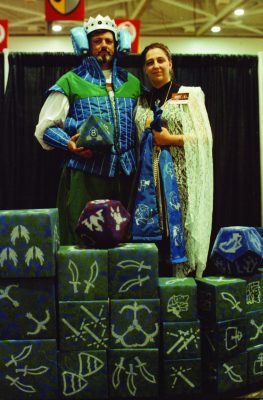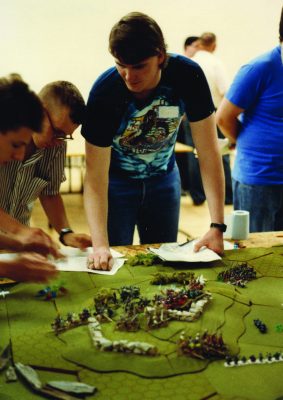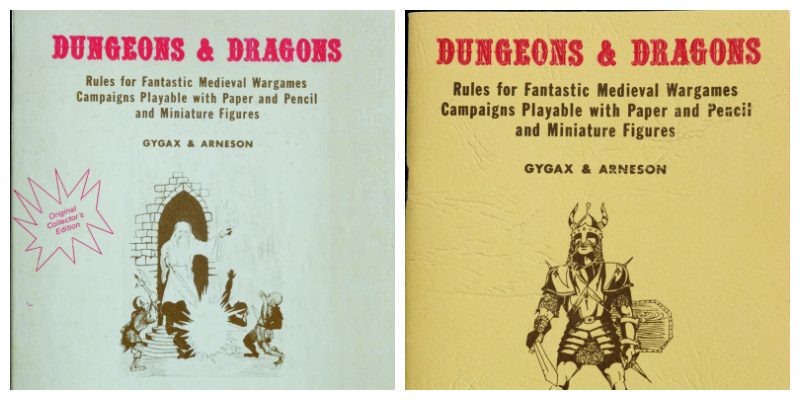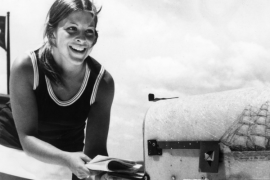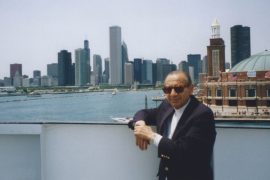By Anne Morrissy
In a pivotal episode of the top-rated CBS TV show The Big Bang Theory that aired in 2013, the show’s famous band of nerds engaged in a high-spirited game of the fantasy role-playing game Dungeons & Dragons. An estimated 16.3 million viewers tuned in to watch that episode when it first aired and countless more will see it in re-runs and syndication, proving that Dungeons & Dragons, a game invented 40 years ago in a Lake Geneva basement maintains an iconic place in the public consciousness.
In the 1980s, Dungeons & Dragons, or D&D to those in the gaming community, rocketed to mass popularity: in 1983, the New York Times mused that it might become “the great game of the 1980s,” a prescient observation that eventually proved correct.
To role-playing game fans and devoted players of Dungeons & Dragons, Lake Geneva is something like a holy Mecca. It was here in 1968 that local gamer E. Gary Gygax (“Gary” to everyone who knew him) first organized a small convention for game enthusiasts at Horticultural Hall that he called (as a tongue-in-cheek homage to his love of history) the “Geneva Convention” or Gen Con. It was here in 1972 that Gygax sat down with his friend and fellow gamer Dave Arneson and first played an early prototype of what would eventually become Dungeons & Dragons. And from the 1970s to the 1990s, Lake Geneva would be the worldwide headquarters of TSR, Inc., the company that Gygax founded to publish and distribute this new gaming phenomenon, spawning a universe of related products and paving the way to the world of games we live in today.
IMAGINATION: THE ESSENCE AND LEGACY OF E. GARY GYGAX
Gary Gygax was born in Chicago in 1938, but moved to Lake Geneva at the age of 8 when his parents decided to return to his mother’s hometown. Gygax’s father was a Swiss immigrant who played in the Chicago Symphony Orchestra and his mother was descended from early pioneer settlers of Walworth County. According to Gygax’s wife Gail, his mother was an avid reader of fantasy novels and even dabbled in writing herself. “I recently found the 1923 yearbook from the old Lake Geneva High School,” she says. “Gary’s mother wrote the foreword for the freshman class that year and it was done in a fantasy vein.” As a child, Gygax was steeped in a world of imagination. His mother read him fantasy stories and his father told him fairy tales from his native Switzerland. “My father was always a storyteller,” remembers Gygax’s son (and TSR employee) Ernest.
As an adult, Gygax became a successful insurance underwriter in Chicago, but he had a passionate hobby: games. In the 1950s when tabletop miniature war games were introduced to the market, Gygax became an avid player, eventually designing his own variants of the games and playing with other fans in a local gaming club and via mail. In 1967, the year he moved back to Lake Geneva from Chicago, he formed the International Federation of Wargamers to share his hobby with other local gamers. He built a large
sand table in his basement at 330 Center Street in Lake Geneva and used it to stage miniature war games with like-minded friends. That year, he organized a 20-person gaming convention in his basement. The event proved so popular that the next year he rented Horticultural Hall and named the event “Gen Con.”
BIRTH OF A NEW GENRE
In 1969, at the second Gen Con at Horticultural Hall, Gygax met a fellow gamer and University of Minnesota student named Dave Arneson. Despite the age difference, they quickly became friends and collaborators. By this time, Gygax was freelancing with several war game publishers to write supplements and extensions for the games he loved so much. In one of these supplements, Gygax developed a fantasy-themed extension derived from characters featured in the novels of J.R.R. Tolkien (The Hobbit was a favorite of Gygax’s.) Arneson applied these fantasy elements to an extension of one of the war games he and Gygax played together and called it the Blackmoor Campaign. The two friends sat down to play Arneson’s version in 1972 and realized they were on the cusp of something big.
Prior to that time, most games fell into a few broad categories: classics like chess and checkers, card games, dice games, board games and the relatively new invention of war games that utilized miniature figures moving around a field according to a complicated book of rules. In 1972, building on the concept of these war games, Gygax and Arneson began collaborating on an entirely new kind of game they called “The Fantasy Game” that combined elements of board games, war games and dice games but added an interesting twist — each player assumed a character and made decisions as that character in order to advance play. Each level that a player achieved unlocked new powers and abilities for that character. Arneson and Gygax had invented the first role-playing game.
Realizing the marketability of their new concept, Gygax began seeking capital to publish and distribute the game, which was now renamed Dungeons & Dragons. Partnering with local backers Don Kaye and Brian Blume, he founded a company he called Tactical Studies Rules (it would eventually be rechristened TSR Inc.) in October of 1973 and distributed the first commercial version of Dungeons & Dragons in January of 1974.
“It was incredible,” remembers Jim Ward, an early fan of the game and eventually an employee of the company. “I was entranced … it allowed me to use my imagination. In my first game, I remember, I fought and dealt with King Kong … it was just great.”
Initially Gygax published just 1,000 copies of the game and sold them for $10 each at hobby shops and gaming conventions. They sold out in less than a year. The meteoric rise of Dungeons & Dragons had begun.
EXPANSION AND UNCERTAINTY
Almost immediately, the game’s success inspired a host of related ventures. Gygax founded a magazine called The Strategic Review (later called The Dragon) to provide a periodical for role-playing gamers. He wrote and published supplements for Dungeons & Dragons to extend play of the game. He and Blume developed a historical role-playing game called Boot Hill, and came out with a version of Dungeons & Dragons developed specifically for young players. They also opened a hobby shop in Gygax’s basement to sell their products, run by Gygax’s son Ernest who eventually became the executive vice president in charge of consumer services.
They were so successful in their first few years that by 1977 the fledgling company had outgrown its headquarters in the Gygax home. They bought the Hotel Clair in downtown Lake Geneva (now the Landmark Center) and converted it for their use. “We stripped out the bowling alley in the basement and that turned into the shipping department,” remembers longtime game developer Tom Wham. “The bar upstairs became the Dungeon Hobby Shop.” The top two floors which had previously been guest rooms became the offices of TSR Inc.
By 1981, there were more than three million Dungeons & Dragons players around the world. Unfortunately, success was already taking its toll on the young company. The need for quick capital and the sudden death of one of the original investors left Gygax a minority shareholder in his own company, a situation which eventually led to infighting between Gygax and his majority shareholders. “It was really cool in [the early] days,” remembers Wham. “Everyone was friendly, there were no hostilities at that time. But as the money started rolling in, greed started happening.”
The rapid expansion of the company was straining its resources. By 1983, TSR had established a Hollywood division, and Gygax temporarily decamped from Lake Geneva to work on a Dungeons & Dragons cartoon series and to shop D&D movie scripts to production companies, most of which never materialized. By this time, the company was hemorrhaging money, which ultimately necessitated a significant round of layoffs at the Lake Geneva headquarters. “At the great firing in 1983, they reduced their workforce by about half,” remembers Wham. Moving the company into a large warehouse space on Sheridan Springs Road gave the company more space for its shipping operations. But by the end of 1985, tensions among the shareholders would lead to a hostile takeover and the eventual ousting of Gygax from his own company.
NOVELIZATION: THE DRAGONLANCE PROJECT
Gygax returned from California in 1984 and in his last year with the company, he began a new venture: novels. Inspired by the success of so-called “choose your path” books like the Choose-Your-Own-Adventure Series, TSR branched into the book business with a series they called Endless Quest. The books were so popular that the creative team at TSR went to work on a new game that would tie in with its own book series. It was called The Dragonlance Project.
Freelance writer Margaret Weis was hired at that time to work on the book side of the Dragonlance Project. “My job was to work with the game department,” she says. “There were 12 modules to the game — it was huge. My job was to distill that down into a plot for the books.”
Initially, TSR intended to hire a famous fantasy writer for the book, but the more Weis worked with the plot, the more she wanted to write it herself. Together with Tracy Hickman, her partner on the book side of the project, Weis wrote five chapters on spec in one weekend and presented it to Jean Black, the head of the book department. “She told me later that she only read it because she didn’t want to hurt our feelings,” Weis remembers, laughing. “We waited an hour sitting in my cubicle. But she loved it.”
Weis and Hickman went on to write several more Dragonlance novels together and the book department at TSR continued to thrive. Today, the Dragonlance series is one of the most popular fantasy franchises in the genre, with more than 190 novels (by a variety of authors) selling in excess of 22 million copies. Weis attributes the success of the novels to the imaginative world she and Hickman were able to create and the presence of strong female characters which brought more women into the previously all-male world of Dungeons & Dragons. She also credits the concept with spawning a new kind of fantasy novel, one inspired by a game. “As far as I know, this was the first novel that had ever been written for a game,” Weis says. “And it was the first game that ever had a set plot.”
VICTIMS OF THEIR OWN SUCCESS
By the early 1990s, heightened competition in the form of computer games and rival fantasy games took its toll on Dungeons & Dragons. TSR still had the upper hand in the game industry, but that would soon change. “It was sweet up until 1994,” remembers Ward. “TSR was on the top of the heap. We were the biggest [role-playing game] company, we had the most employees, the most products. Every single hobby store had to have every game we made.” But the introduction of computer games began to erode the attention spans of the average gamer and competition from rival card game Magic: The Gathering siphoned off some of the interest in role-playing games.
With Gygax out of the picture and the company’s finances overextended, by 1997 the leadership was ready to accept an offer from Washington-based game company Wizards of the Coast to buy TSR. Under the terms of the sale, many of the company’s employees were offered a transfer to the west coast, and with that, the game that had been invented in Lake Geneva was local no more.
THE GAME’S LEGACY
Today, parent company Hasbro Inc., owns Wizards of the Coast and licenses the Dungeons & Dragons patents to smaller game developers who continue to create new modules and versions of the game. An online version exists as well, and in 2007, the company estimated that around six million people played some version of Dungeons & Dragons worldwide.
The annual gaming convention known as Gen Con that started in Gygax’s basement on Center Street is now the largest gamer’s convention in North America and meets each year in Indianapolis. This year, the event attracted more than 56,000 unique attendees.
But Gygax’s son Ernest says the real legacy of Dungeons & Dragons is all of the imitators that came after it, including the slew of computer role-playing games now popular. “The real concept [my dad] came up with is the idea of a level progression and rewards session,” he explains. “If someone plays FarmVille or Warcraft, every time they go up a level and become more capable, that’s my dad’s creation. That’s his real work.” Asked if those games will ever fully supersede the game his father invented, Ernest is optimistic. “My dad’s stuff is still read by millions around the world. Hopefully Dungeons & Dragons will last forever.”


